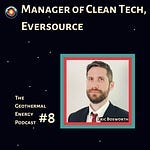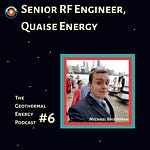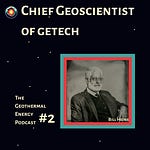In this episode, we sit down with Tim Lines, a petroleum engineer turned geothermal advocate, whose career spans 40+ countries in oil & gas, district heating, and now geothermal innovation. We explore how he was drawn into the sector, the technical-economic feasibility of geothermal at scale, and his company’s work to advance projects in the UK and abroad.
⏱️ Timestamps
00:00 - Introduction, What led Tim to geothermal and why now? Exploration of future of geothermal energy
7:08 - Breaking down more of the future of geothermal in Texas report
12:30 - How are current technologies trying to solve the heat issues for drilling with geothermal? What can other geothermal developers learn?
17:32 - Digging into different drilling fluids and which make more sense to use
21:20 - How can we get better at processing and reducing errors in sensing data in the context of geothermal drilling?
23:57 - European SPE Geothermal Energy Hackathon
28:48 - How have your assumptions about geothermal energy changed as you’ve been involved in the field? Tim also discusses one of the projects he’s been working on in the UK and discusses the different partners and techniques he’s used to find success
41:09 - Discussing how drilling and fracking has changed from the 90s to today
46:05 - How can we keep pricing for geothermal competitive? What political and economic tools are available?
52:40 - Examples of countries doing great jobs with feed in tariffs for geothermal
59:28 - How can we work with local partners to create unique solutions to water problems for geothermal? (in this case, Tim worked with local municipalities to build a reservoir)
1:07:03 - What are the challenges of bringing American drilling technologies abroad?
1:10:52 - Who are the different segments of customers for geothermal projects? What are their differing needs?
1:23:57 - What are the different challenges with customer discovery for geothermal? What tools are out there?
1:28:56 - What are the challenges to getting different offtakers involved? How can we get them excited about geothermal?
1:30:48 - How do American and international offtakers differ in needs?
1:32:56 - How does your team source equipment and talent for geothermal development?
1:39:17- What is the most important problem that, if we could solve it today, would totally change things?
🎙 Why Geothermal, and Why Now?
Tim explains how his journey into geothermal began with the Society of Petroleum Engineers (SPE) and later deepened through Jamie Beard’s invitation to contribute to the Texas Geothermal Report. His rigorous bottom-up modeling compared geothermal’s potential against IEA forecasts—and revealed the resource could, technically, meet a large amount of global energy demand by 2050.
You can read the newest IEA report on Geothermal Energy here.
🔢 How Do You Calculate Geothermal’s Potential?
Tim walks through his methods—reservoir assumptions, gradients, power conversion models, and capital cost estimates. Initially, he assumed ~3–4 MW per well pair. But projects like Fervo’s at Utah FORGE have since shown yields closer to 10 MW, with the potential for much higher.
⚡️ Updating the Assumptions: From 3 MW to 25 MW+
What would Tim change today? Higher well yields, multiple laterals around a single injector, and innovations in pumping to boost flow rates. He sees pathways toward 25+ MW per “well unit,” crucial for serving hyperscaler data centers and other industrial loads.
NREL has also published tools (read more here and here) that helped him through this process.
🛠 The Engineering Challenges of High-Temperature Wells
We dig into hurdles like:
MWD tools frying at 175–200°C and solutions like mud cooling.
High-temperature cement integrity in projects like Iceland’s magma drilling.
Fracture conductivity loss over time, requiring stronger proppants.
💻 Hackathons and Engaging Young Engineers
Through SPE, Tim helped launch geothermal hackathons in Europe (newest one can be found here), blending data science and reservoir engineering. These programs brought students and young professionals worldwide into real geothermal problem-solving—creating a pipeline of new ideas and talent.
🏗 Lessons from Looking Globally
Tim reflects on how the broader global market looks for Geothermal Energy:
Early assumptions about rapid rollouts were optimistic.
The US remains tough, given cheap natural gas.
Focus has shifted to regions with feed-in tariffs/energy incentives (e.g., U.K.’s CfD, Germany’s Renewables Energy Act, Taiwan’s FITs, Japan’s Feed in Tariffs), effectively promising higher prices energy producers an above-market price and long term certainty and demand to help derisk renewable energy investments.
Heat networks are a powerful way to deliver low-cost social benefits—and attract municipal partners. Check out our episode with Eric Bosworth for more.
💧 Water, Reservoirs, and Creative Solutions
Supplying enough water for fracking is a major challenge. Tim’s UK projects explore options like:
Building reservoirs (a community amenity with biodiversity benefits).
Leveraging wastewater streams (e.g., from sewage treatment plants).
Exploring shallow aquifers for brine sources.
Developing and works with local partners (i.e. NHS working with Geothermal together for key parts of the geothermal project)
📈 Customers, Offtakers, and Market Discovery
Who buys geothermal power and heat?
Electricity: utilities, microgrids, data centers, industrial plants. Can often provide these customers a hedge against fluctuating gas prices.
Heat: municipalities, district networks, hospitals, and industrial steam users (paper, cement, chemicals).
Challenge: geothermal wells produce more heat than most customers can use, requiring cascaded applications to capture full value (i.e. pairing a local producer who needs high heat with geothermal energy production, chaining high and low heat need customers to allow for multiple stakeholder geothermal projects, etc.)
Project Innerspace’s has also provided GeoMap to help this process — It’s on open-access tool combining subsurface heat data with surface-level energy demand, helping developers spot promising project locations.
Opportunity: A new kind of player that could aggregate geothermal supply and route it to diverse customers (like pipeline companies do in oil & gas).
🌐 Incentives and Policy Lessons
Outside the US, feed-in tariffs (see Lessons from Founding Geothermal Wells) and insurance products (i.e. Munich Re) de-risk early-stage projects.
Tim stresses that faster permitting, long-term pricing certainty, and community trust are essential for scaling geothermal worldwide.
🚀 What Problem Would Change Everything? (Need’s Tim Review)
Paraphrasing Tim’s words: If we could dramatically increase yield per well unit—from today’s 10 MW to 50–70 MW—that would change everything.
Higher yields mean fewer wells, faster buildouts, and the ability to serve massive loads like hyperscaler data centers competitively.
The lever: reduce parasitic losses in the reservoir — the friction and pressure drop when forcing water through fractures.
The vision: One injector with three producers could deliver ~55 MW net. A dozen such “well units” could power a 1 GW data center.
📚 Where to Learn More
Tim’s contributions to the Texas Geothermal Report
Mentioned Podcasts
Tim Tarver (Exceed GeoEnergy) — Advanced geothermal drilling, fracking challenges, and water reuse.
Jen Wakeland (Beaver County, Utah) — Community engagement, rural development, and transmission planning.
Bill Heins (Getech) — Insurance products and de-risking geothermal projects in Europe.
Eric Bosworth (Eversource) (Part 1, Part 2) — Utility-led networked geothermal and lessons from the Framingham pilot.
Ken Wisian (Bureau of Economic Geology, Texas) (Part 1, Part 2)— Military applications of geothermal and energy security.










